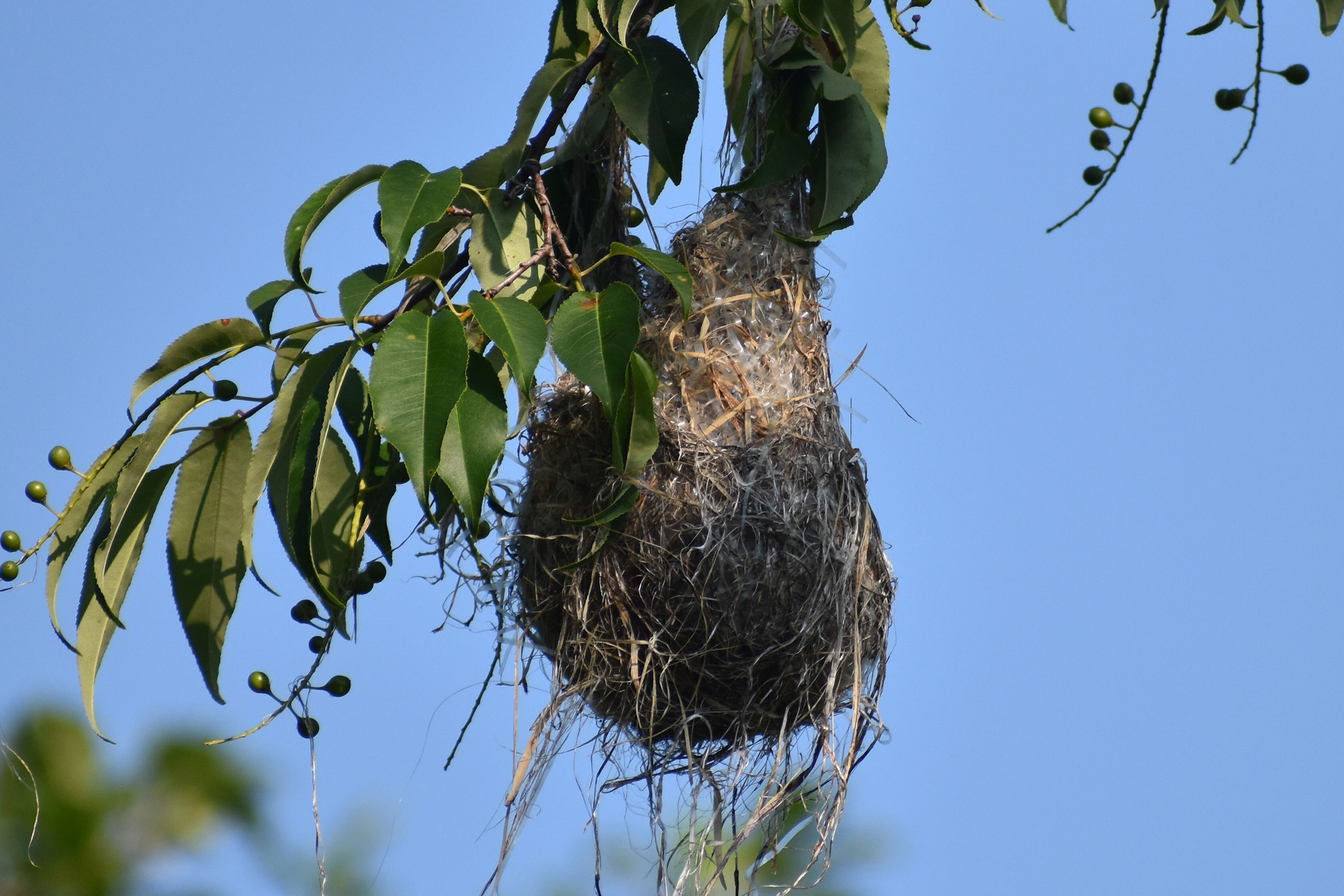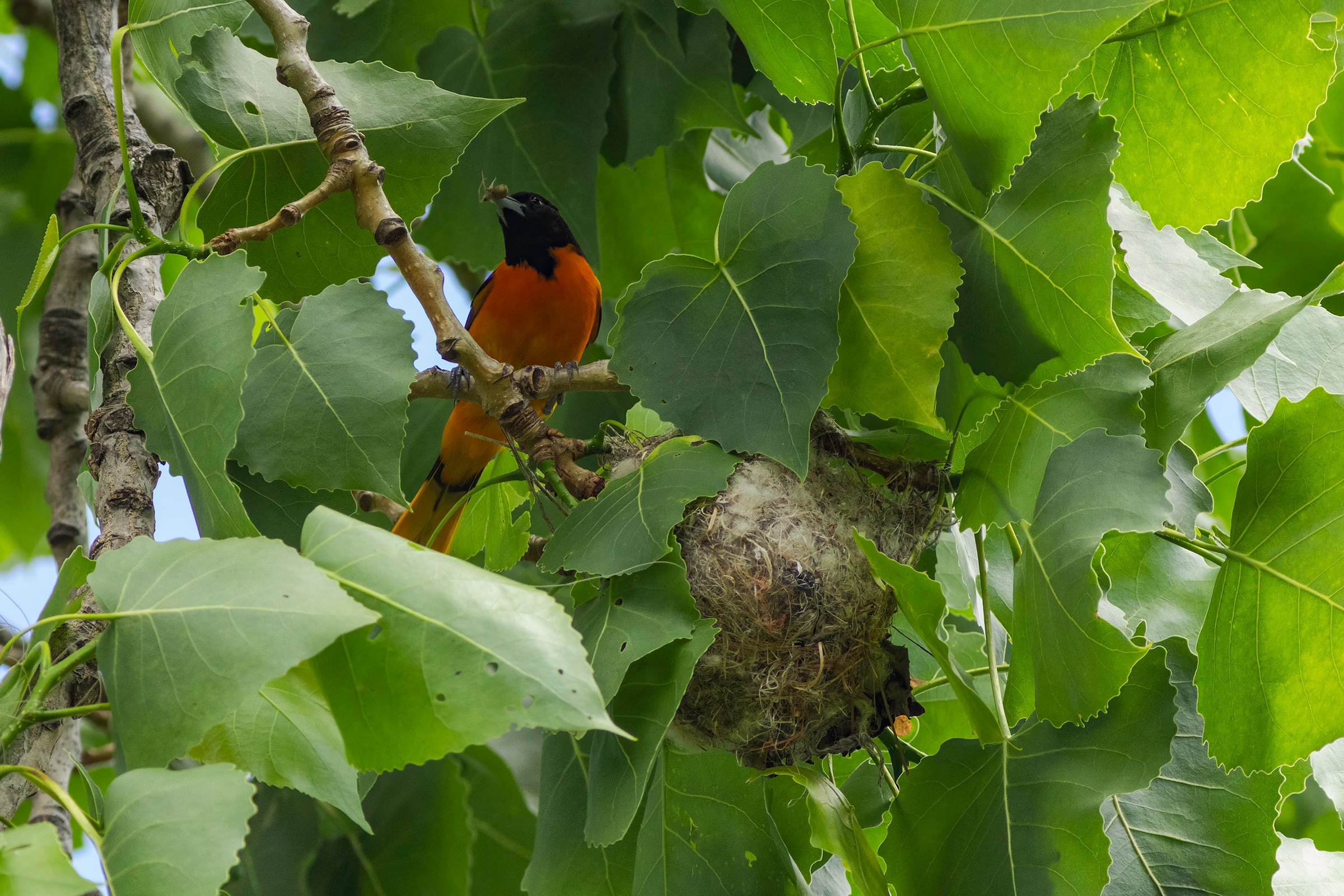Introduction
No matter how many times you have seen a Baltimore Oriole, they are always magnificent. Dancing from limb to limb, the male’s bright orange and bold black plumage captures the eye like no other species in Virginia. Like females, young male Baltimore Orioles (less than one year old) sport subdued yellow-orange and gray plumage. The species nests in open woodlands and forest edges, often in riparian settings. Females weave hanging nests, like fine baskets made from plant fibers (Rising and Flood 2020).
Breeding Distribution
Baltimore Orioles are found in all regions of Virginia but are most likely to occur in the Mountains and Valleys region (Figure 1). This result is not unexpected, as the Mountains and Valleys region covers the primary Baltimore Oriole breeding range within the state and supports the highest quality habitat. In addition, the species is highly likely to occur in northwestern counties within the Piedmont region. The likelihood of Baltimore Orioles occurring in a block increases in tandem with forest cover, agricultural lands (can include association with hay/pasture if nesting at forested edge of field), and developed areas. In contrast, the species’ likelihood of occurring decreases in a block when the proportion of shrubland and grassland habitats, the number of habitat types, and the amount of unfragmented forest increase.
Between Atlases (Figures 1 and 2), Baltimore Oriole’s likelihood of occurring decreased throughout much of the Piedmont region, especially in the Richmond and Northern Virginia areas, while in the western parts of Fauquier and Loudon Counties, it remained constant. It also decreased in the Hampton Roads-Virginia Beach area, while its occurrence in the Mountains and Valleys remained generally constant, except in the southwestern corner (Figure 3).
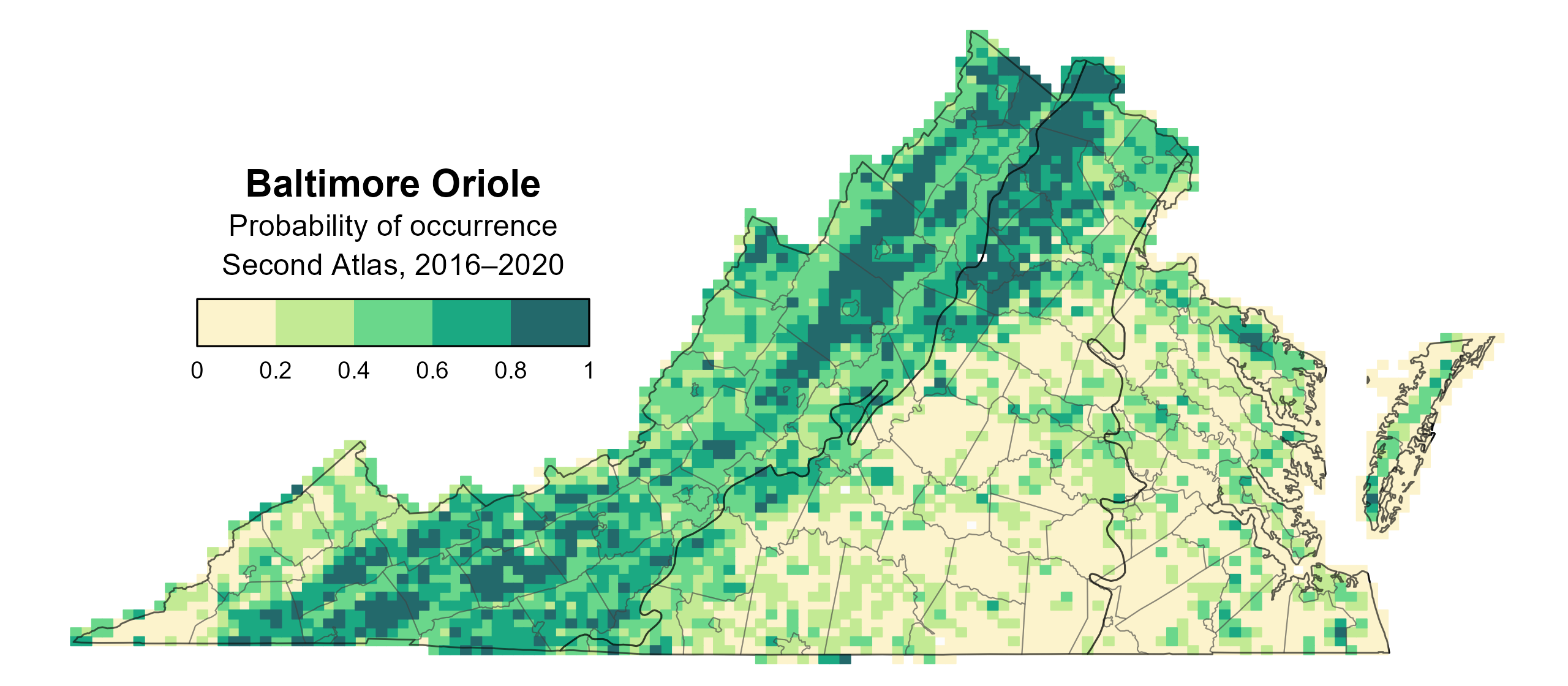
Figure 1: Baltimore Oriole breeding distribution based on probability of occurrence (Second Atlas, 2016–2020). This map indicates the probability that this species will occur in an Atlas block (an approximately 10 mi2 [26 km2] survey unit) based on environmental (including habitat) factors and after adjusting for the probability of detection (variation in survey effort among blocks).
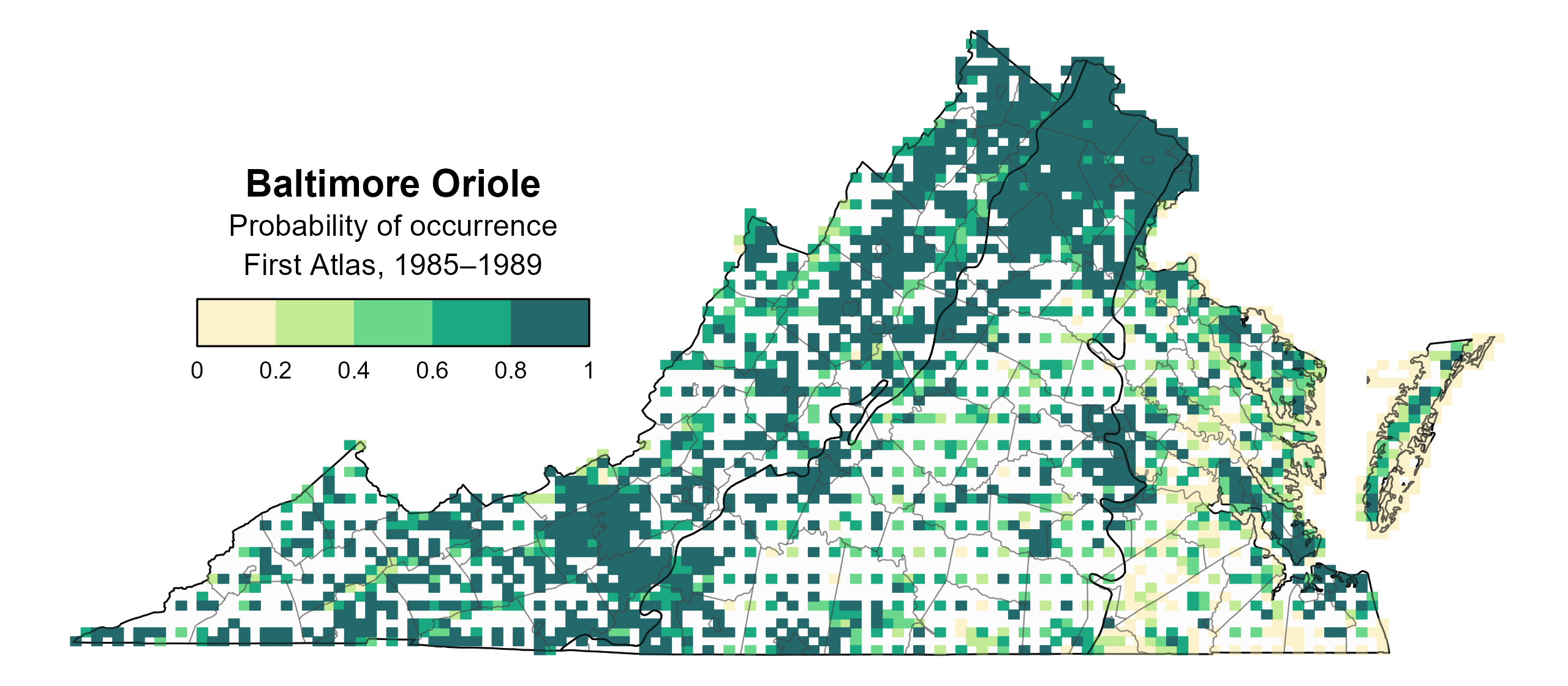
Figure 2: Baltimore Oriole breeding distribution based on probability of occurrence (First Atlas, 1985–1989). This map indicates the probability that this species will occur in an Atlas block (an approximately 10 mi2 [26 km2] survey unit) based on environmental (including habitat) factors and after adjusting for the probability of detection (variation in survey effort among blocks). Blocks in white were not surveyed during the First Atlas and were not modeled.

Figure 3: Baltimore Oriole change in breeding distribution between Atlases (1985–1989 and 2016–2020) based on probability of occurrence. This map indicates the change in the probability that this species will occur in a block (an approximately 10 mi2 [26 km2] survey unit) between Atlas periods. Blocks with no change (tan) may have constant presence or constant absence. Blocks in white were not surveyed during the First Atlas and were not modeled.
Breeding Evidence
Baltimore Orioles were confirmed breeders in 234 blocks and 54 counties and probable breeders in 16 additional counties (Figure 4). As expected, given the distribution of Baltimore Orioles within the state, most breeding observations were recorded in the Mountains and Valleys region during both Atlases (Figures 4 and 5).
The earliest confirmed breeding behavior was of adults carrying nesting materials on April. 17. However, breeding was confirmed primarily through observations of occupied nests (May 10 – July 3), adults carrying food (May 21 – July 9), and recently fledged young (June 1 – July 30) (Figure 6).
For more general information on the breeding habits of this species, please refer to All About Birds.

Figure 4: Baltimore Oriole breeding observations from the Second Atlas (2016–2020). The colored boxes illustrate Atlas blocks (approximately 10 mi2 [26 km2] survey units) where the species was detected. The colors show the highest breeding category recorded in a block. The numbers within the colors in the legend correspond to the number of blocks with that breeding evidence category.
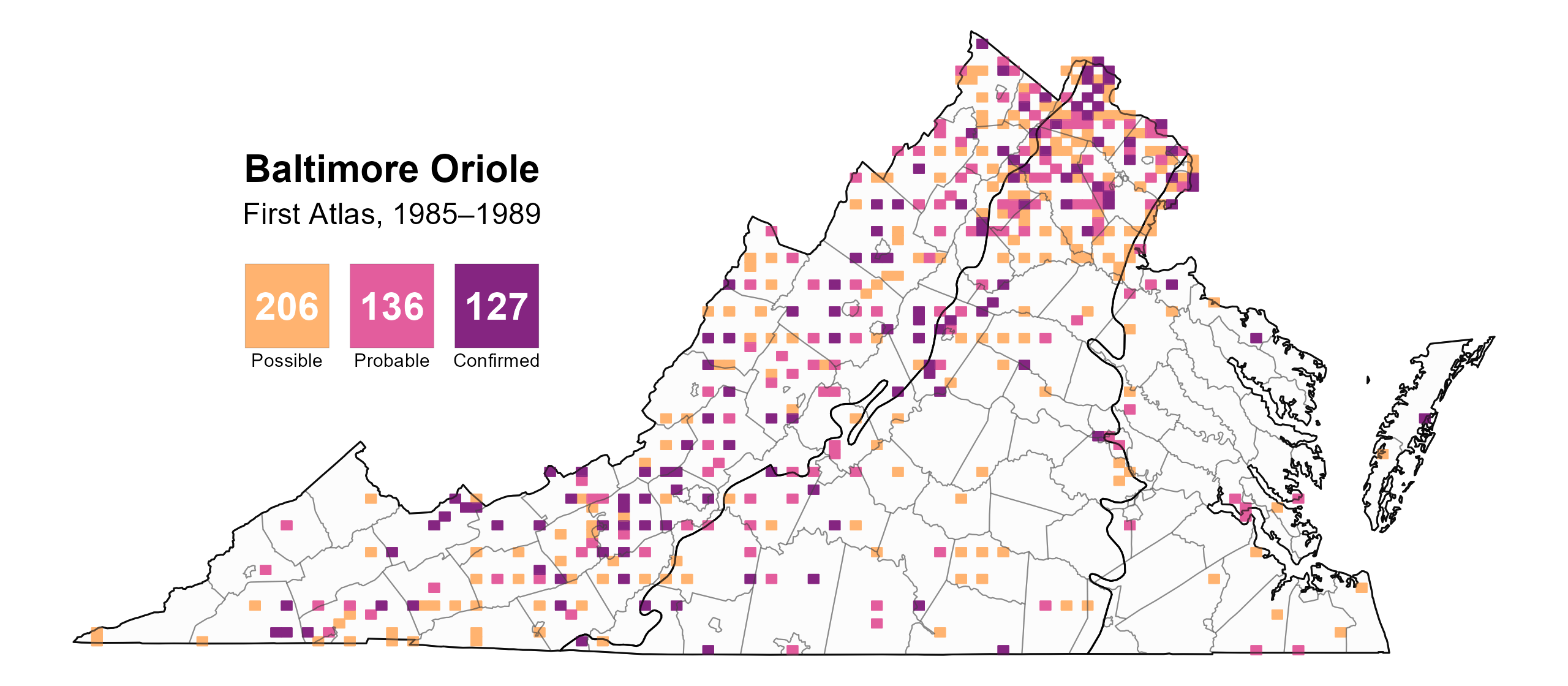
Figure 5: Baltimore Oriole breeding observations from the First Atlas (1985–1989). The colored boxes illustrate Atlas blocks (approximately 10 mi2 [26 km2] survey units) where the species was detected. The colors show the highest breeding category recorded in a block. The numbers within the colors in the legend correspond to the number of blocks with that breeding evidence category.

Figure 6: Baltimore Oriole phenology: confirmed breeding codes. This graph shows a timeline of confirmed breeding behaviors. Tick marks represent individual observations of the behavior.
Population Status
Baltimore Oriole relative abundance was estimated to be highest in the Mountains and Valleys region, decreasing moving east through the state (Figure 7).
The total estimated Baltimore Oriole population in the state is approximately 176,000 individuals (with a range between 97,000 and 320,000). Based on the North American Breeding Bird Survey (BBS), the Baltimore Oriole population decreased by a nonsignificant 0.67% annually from 1966–2022 in Virginia, and between Atlas periods, BBS data showed a nonsignificant decline of 0.02% per year from 1987–2018 (Hostetler et al. 2023; Figure 8).

Figure 7: Baltimore Oriole relative abundance (Second Atlas, 2016–2020). This map indicates the predicted abundance of this species at a 0.4 mi2 (1 km2) scale based on environmental (including habitat) factors. Abundance values are presented on a relative scale of low to high.
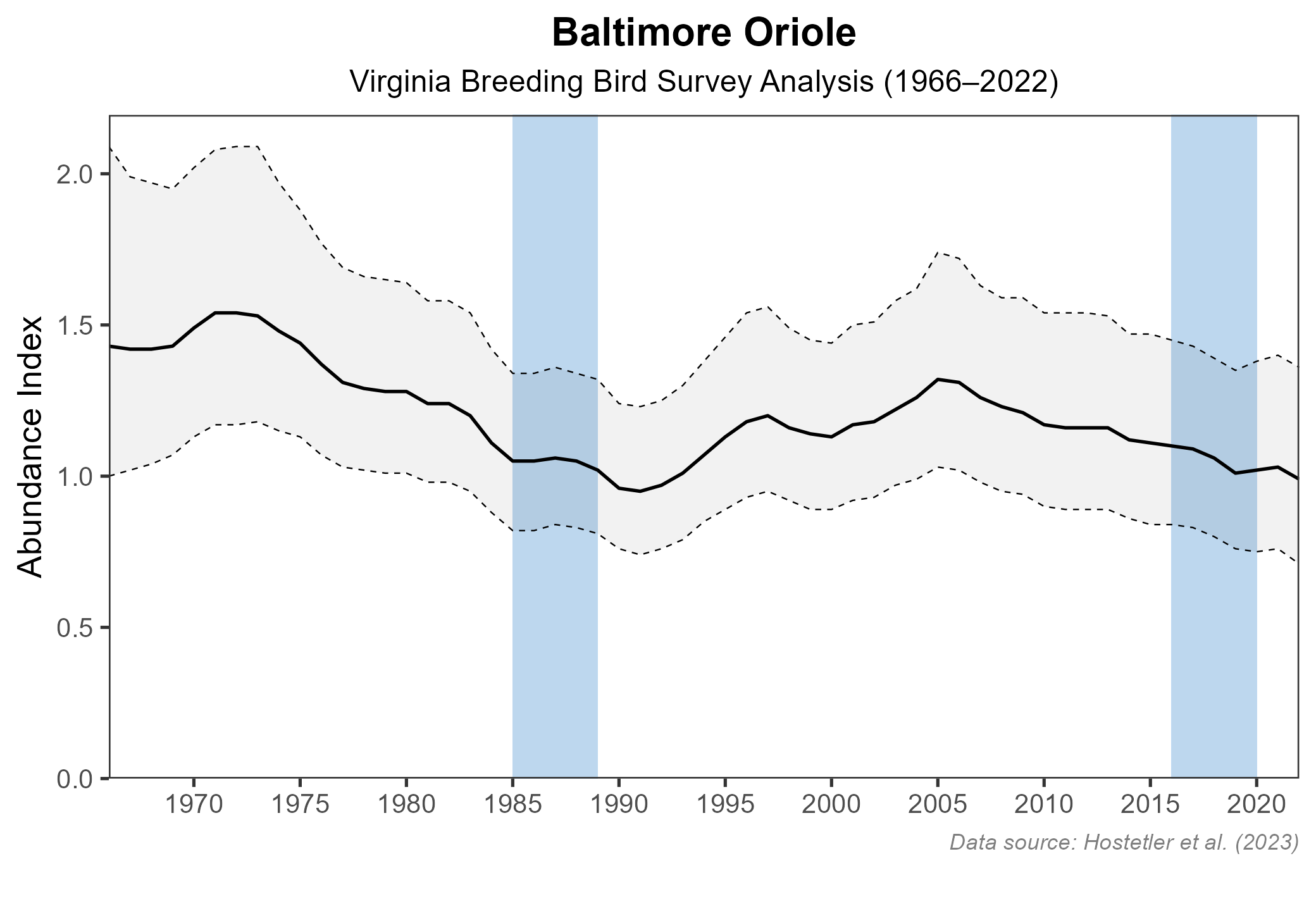
Figure 8: Baltimore Oriole population trend for Virginia as estimated by the North American Breeding Bird Survey. The vertical axis shows species abundance; the horizontal axis shows the year. The solid line indicates the estimated population trend; there is a 97.5% probability that the true population trend falls between the dashed lines. The shaded bars indicate the First and Second Atlas periods.
Conservation
Baltimore Orioles are common and stable in Virginia and throughout their range (Rising and Flood 2020). They are not considered a species of conservation concern, and no species-specific conservation projects are underway in Virginia.
Interactive Map
The interactive map contains up to six Atlas layers (probability of occurrence for the First and Second Atlases, change in probability of occurrence between Atlases, breeding evidence for the First and Second Atlases, and abundance for the Second Atlas) that can be viewed one at a time. To view an Atlas map layer, mouse over the layer box in the upper left. County lines and physiographic regional boundaries (Mountains and Valleys, Piedmont, and Coastal Plain) can be turned on and off by checking or unchecking the box below the layer box. Within the map window, users can hover on a block to see its value for each layer and pan and zoom to see roads, towns, and other features of interest that are visible beneath a selected layer.
View Interactive Map in Full Screen
References
Hostetler, J. A., J. R. Sauer, J. E. Hines, D. Ziolkowski, and M. Lutmerding (2023). The North American breeding bird survey, analysis results 1966–2022. U.S. Geological Survey, Laurel, MD, USA. https://doi.org/10.5066/P9SC7T11.
Rising, J. D., and N. J. Flood (2020). Baltimore Oriole (Icterus galbula), version 1.0. In Birds of the World (P. G. Rodewald, Editor). Cornell Lab of Ornithology, Ithaca, NY, USA. https://doi.org/10.2173/bow.balori.01.



